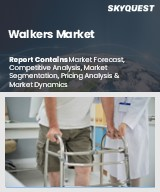
보행기 세계 시장 규모는 2023년에 16억 달러, 2024년 17억 2,000만 달러에서 2032년에는 30억 9,000만 달러로 성장하고, 예측 기간(2025-2032년) CAGR은 7.6%를 보일 전망입니다.
세계 보행기 시장은 재택 헬스케어 솔루션에 대한 선호도 증가와 함께 고령화 인구의 확대와 이동 관련 장애 증가에 큰 영향을 받고 있습니다. 경량 알루미늄 프레임, 인체공학적 핸들, 안전성 향상을 위한 MEMS 기반 센서 및 GPS와 같은 첨단 스마트 기능 등 보행기 기술 혁신이 사용자 경험을 재구성하고 있습니다. 니트로 유로 스타일 롤러와 같은 제품은 조절 가능한 기능과 편안한 착석감을 제공하며 이러한 진보를 상징합니다. 고령화 추세는 관절염이나 파킨슨병과 같은 증상을 가진 사람들의 일상생활을 개선하기 위해 조정된 미적, 기능적 이동 보조기구에 대한 수요를 더욱 촉진하고 있습니다. 그러나 스마트 기술의 통합은 윤리와 프라이버시에 대한 심각한 우려를 불러일으키기 때문에 사용자의 신뢰를 유지하고 시장 성장을 가속하기 위해서는 강력한 데이터 암호화와 규제 준수가 중요하다는 점이 강조되고 있습니다.
Global Walkers Market size was valued at USD 1.6 billion in 2023 and is poised to grow from USD 1.72 billion in 2024 to USD 3.09 billion by 2032, growing at a CAGR of 7.6% during the forecast period (2025-2032).
The global walkers market is significantly influenced by an expanding aging population and a rise in mobility-related disorders, alongside an increasing preference for home healthcare solutions. Innovations in walker technology, including lightweight aluminum frames, ergonomic handles, and advanced smart features such as MEMS-based sensors and GPS for enhanced safety, are reshaping user experience. Products like the Nitro Euro Style Rollator exemplify these advancements, offering adjustable features and comfortable seating. The trend of aging-in-place is further driving demand for aesthetically pleasing and functional mobility aids tailored to enhance the daily lives of individuals with conditions like arthritis and Parkinson's disease. However, the integration of smart technologies raises critical ethical and privacy concerns, emphasizing the importance of robust data encryption and compliance with regulations to maintain user trust and promote market growth.
Top-down and bottom-up approaches were used to estimate and validate the size of the Global Walkers market and to estimate the size of various other dependent submarkets. The research methodology used to estimate the market size includes the following details: The key players in the market were identified through secondary research, and their market shares in the respective regions were determined through primary and secondary research. This entire procedure includes the study of the annual and financial reports of the top market players and extensive interviews for key insights from industry leaders such as CEOs, VPs, directors, and marketing executives. All percentage shares split, and breakdowns were determined using secondary sources and verified through Primary sources. All possible parameters that affect the markets covered in this research study have been accounted for, viewed in extensive detail, verified through primary research, and analyzed to get the final quantitative and qualitative data.
Global Walkers Market Segments Analysis
Global Walkers Market is segmented by Type, Application, End User and region. Based on Type, the market is segmented into Standard walkers, Wheeled walkers and Knee walkers. Based on Application, the market is segmented into Orthopedic care, Geriatric care and Emergency care. Based on End User, the market is segmented into Hospitals and Home care. Based on region, the market is segmented into North America, Europe, Asia Pacific, Latin America and Middle East & Africa.
Driver of the Global Walkers Market
The growing global population of elderly individuals significantly boosts the demand for walkers, as age-related mobility challenges arise from various conditions and disorders, including arthritis. This trend is particularly pronounced in regions like North America and Europe, where a large demographic requires assistance in maintaining their independence and mobility. As more individuals seek to enhance their quality of life through improved mobility solutions, the market for walkers continues to expand. This surge in demand reflects a broader need for supportive devices that aid the elderly in navigating their environments with greater ease and confidence.
Restraints in the Global Walkers Market
The Global Walkers market faces significant challenges due to the high cost of advanced walkers equipped with features like height adjustability, comfortable seating, and integrated storage solutions, which usually range from $100 to $500. Such pricing makes these products inaccessible for a large portion of potential buyers, particularly in developing regions like India, Brazil, and parts of Africa where disposable incomes are limited. As a result, many frugal consumers opt for lower-quality, budget-friendly alternatives or may forgo mobility aids entirely. This pricing barrier hinders market penetration and ultimately restricts overall growth in these underserved segments.
Market Trends of the Global Walkers Market
The Global Walkers market is witnessing a significant shift towards smart and connected devices, driven by advanced technology and rising consumer demands. Walkers equipped with features like fall sensors, GPS tracking, and health monitoring are becoming increasingly prevalent, particularly among high-income populations in North America and Europe. Prominent companies, such as U-Step, are innovating to enhance user safety and provide real-time data to caregivers, aligning with the broader trend of tech-driven healthcare solutions. This evolution not only improves mobility for users but also reflects the growing integration of digital health tools, ultimately transforming how elderly and mobility-impaired individuals navigate their environments.